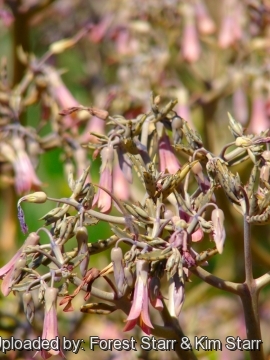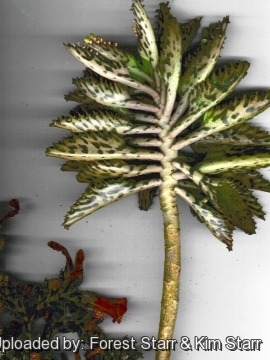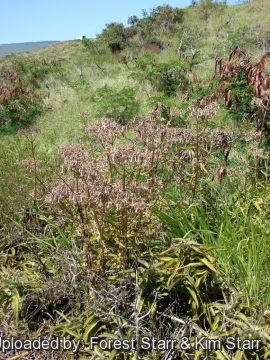




Your support is critical to our success.
Ann. Inst. Bot.-Geol. Colon. Marseille sér. 3, 2: 128. 1914
Family: CRASSULACEAE

Origin and Habitat: Kalanchoe daigremontianaSN|14430]]SN|14430]] is native to the Fiherenana River valley and Androhibolava mountains in southwest Madagascar. It has been introduced to numerous tropical and subtropical regions, such as Florida and in coastal southern Texas, Puerto Rico, Pacific islands (Galápagos, Hawaii, Fiji, Marshal, New Caledonia, Niue) subtropical Africa and South Africa, Australia (Queensland), India, Pakistan, China, New Zealand, and parts of the Canary Islands.
Habitat and ecology K. daigremontiana is widely cultivated in gardens in tropical countries. It is well established and an aggressive weed naturalized almost every where and commonly spreading along roadsides and on waste areas, the exudates of its roots can inhibit the growth of nearby plants, as can extracts of its shoots.
Synonyms:
- Kalanchoe daigremontiana Raym.-Hamet & H.Perrier
- Bryophyllum daigremontianum (Raym.-Hamet & H.Perrier) A.Berger
ENGLISH: Mother of Thousands, Palm tree Bryophyllum, Mexican Hat Plant, Alligator Plant, Devil's backbone, Chandelier Plant, Mother of Millions
ARABIC ( لعربية ): طحلبية القبعة المكسيكية, طُحلُبيّة القُبّعة المَكسيكيّة
HUNGARIAN (Magyar): Sarjika, Elevenszülő korallvirág
JAPANESE (日本語): コダカラベンケイ
PERSIAN (فارسی): کالانکوئه دایگریمونتیا
POLISH ( Polski): Żyworódka Daigremonta
PORTUGUESE (Português): Mãe de milhares
RUSSIAN (Русский): Каланxоэ Дегремона
SPANISH (Español): Espinazo del Diablo, Aranto, Siempreviva, Dulcamara
SWEDISH (Svenska): Livsblad
TONGAN (Faka-Tonga): Faʻē ʻa e miliona, Faʻē ʻa e ʻafe, Faʻēʻaemano
UKRAINIAN (Українська): Каланxое Дайгремонта
Description: Kalanchoe daigremontianum (Bryophyllum daigremontianum) also called Mother of Thousands, Alligator Plant, or Mexican Hat is a slender monocarpic, perennials, glabrous, succulent herb. The cylindrical unbranched shoots are erect, about 25–40 cm tall of up to 1cm thickness and closely marked by leaf scars. The leaves are triangular, glaucous bluish green and faintly marked with brownish black spots. The bare stems with the upper whorl of leaves give plants the appearance of miniature palm trees. Like other members of the genus Bryophyllum, it is able to propagate vegetatively from minute plantlets that develop on the leaf edges and are shed one after the other. All parts of the plant are poisonous to humans, stocks and small animals.
Stems: Mostly simple or few branched from the base, stout, terete, 5–40(-150) cm tall and 0.5–2 cm across. Adult plants can also develop lateral root structures on its main stalk, as high up as 10-15 cm from the ground. The main stalk may bend downwards due to the weight of foliage and plantlets, in this case the lateral roots to take up root of their own, anchoring into the soil and eventually developing new primary stalks which establish themselves as independent plants.
Leaves: Opposite, evenly spaced, simple, petiole 1–5 cm long, lamina fleshy, narrowly triangular-hastate to lanceolate, (5-)15–20(-28) long, (2–)3.5–6-(12) cm wide, dark glaucous green above and with purple markings beneath, the base subcordate or auriculate, apex acute, margin coarsely serrate with teeth 5–10 mm apart. The margins of these leaf-like organs have spoon-shaped bulbiliferous spurs that bear young plantlets (bulbils). The plantlets form roots while on the plant.
Inflorescence (cymes): Lax, umbrella-like terminal, paniculate, 1.5–3 dm diameter; branches to 15 cm long. Pedicels 4–15 mm long.
Flowers: Pendulous, large, bell-shaped, bisexual, 4-merous, rose-colored, pink or lavender. Calyx green or purplish, not inflated, 6–10 mm, tube 3–4 mm, lobes triangular, glabrous, acute, 3–7 x 2-4 mm, equaling or longer than tube, apex acute. Corolla tubular, pink or lavender, (18-)20–23(-30) mm long, not contracted basally, lobes obovate, 6–12 mm, apex rounded, apiculate. Filaments inserted at the middle of corolla-tube. Carpels 4, styles smaller than the ovary, numerous ovules per locule. Nectar scales oblong, 1.5-2 x 0.3-1 mm.
Fruit: A group of 4 follicles each of them 7-10 mm long and 2-4 mm.
Seed: 0.6-1 x 0.2-0.3 mm, oblong with longitudinal striae.
Phenology: Flowering is, however, not an annual event and will occur sporadically if at all. Particularly in climates with distinct seasonal temperature differences, flowering is most frequently observed at the beginning of a warm season.
Physiology: Plants of the genus Bryophyllum as well as many other plants growing in arid regions photosynthesize through Crassulacean acid metabolism.
Chromosome number: 2n = 38.
Notes: The plants hybridize easily with several others species especially with Kalanchoe delagoense and Kalanchoe rosei. The most common of its hybrid Kalanchoe x houghtonii (Kalanchoe daigremontiana × Kalanchoe delagoense) is much like K. daigremontiana but with narrower leaves; some specimens identified as K. daigremontiana may possibly be the hybrid. Both K. daigremontiana and its hybrids easily escapes from garden and are noxious weeds in many tropical country. The plants spread by seeds and by plantlets that form on the edges of the leaves. They seem indestructible and are very difficult to eradicate as the seeds remain viable in the soil for many years.
Bibliography: Major references and further lectures
1) Forest & Kim Starr “Kalanchoe daigremontiana (Mother of millions, devil's backbone)”. Plants of Hawaii. <http://www.starrenvironmental.com>. Web. 27 Sep. 2014.
2) Wikipedia contributors. "Bryophyllum daigremontianum." Wikipedia, The Free Encyclopedia. Wikipedia, The Free Encyclopedia, 16 Oct. 2014. Web. 18 Oct. 2014.
3) Everitt, J.H.; Lonard, R.L.; Little, C.R. “Weeds in South Texas and Northern Mexico.” Lubbock: Texas Tech University Press. 2007)
4) Urs Eggli “Illustrated Handbook of Succulent Plants: Crassulaceae” Springer for Science, 01/Jan/2003
5) Jacobsen, H. “Lexicon of Succulent Plants.” Poole, Dorset: Blandford Press. 1970 (Trans. Lois Glass 1977).
6) Rauh, W., “Xerophytic and Succulent Plants of Madagascar” Vols. 1 & 2,. Strawberry Press. 1995 and 1998
7) Umberto Quattrocchi "CRC World Dictionary of Plant Names" Common Names, Scientific Names, Eponyms, Synonyms, and Etymology. CRC Press, 2000
8) http://www.hear.org/pier/species/bryophyllum_daigremontianum.htm
9) Freire Fierro, A. “Crassulaceae.” 73: 4–16. In G. W. Harling & L. Andersson (eds.) Fl. Ecuador. University of Göteborg, Göteborg. 2004
10) “Bryophyllum daigremontianum” <http://www.efloras.org/florataxon.aspx?flora_id=5&taxon_id=242426709> “Flora or Pakistan” Web. 16 Oct. 2014.
11) Reid V. Moran “Kalanchoë blossfeldiana Poellnitz [family CRASSULACEAE] Flora of North America” Vol 8 Magnoliophyta: Paeoniaceae to Ericaceae. Flora of North America Editorial Committee. 2009.
12) Sabina George “Ornamental Plants” New India Publishing, 09/Jul/2009

Along road at Old Kaumalapau Hwy, Lanai, Hawaii (USA). April 02, 2007. Photo by: Forest Starr & Kim Starr

Flowers at Old Kaumalapau Hwy, Lanai, Hawaii (USA). April 02, 2007. Photo by: Forest Starr & Kim Starr

Plant at Kanaio, Maui, Hawaii (USA). March 31, 2004. Photo by: Forest Starr & Kim Starr

Hanging down steep rock slope at Kaumalapau Hwy, Lanai, Hawaii (USA). Photo by: Forest Starr & Kim Starr

Flowering habit at Old Kaumalapau Hwy, Lanai, Hawaii (USA). April 02, 2007. Photo by: Forest Starr & Kim Starr
The gallery now contains thousands of pictures, however it is possible to do even more. We are, of course, seeking photos of species not yet shown in the gallery but not only that, we are also looking for better pictures than those already present. Read More...
Cultivation and Propagation: This plant is almost indestructible, does not require any care... no care at all, it will grow. Sure it like water, but it is very drought tolerant... throw it on the trash piles and it just keeps growing and flowering. Kalankoe daigremontiana isn't hardy to severe freeze, but seem to tolerate everything else. Be careful with this species in outdoor culture, once it gets into a planting bed it is almost impossible to get rid of it, a few tiny plantlets seem to survive any attempt to weeding them out every time, and then they reproduce like crazy again. These are very easy pot plants due to their drought tolerance, and in fact will grow in pretty deep shade without much trouble. Good thing they don't have nasty roots- they can be pulled or scooped away where not wanted. It need to be covered at least and housed in cold climates. They are absolutely gorgeous as a cut flower in a tall stemmed green vase. However the flowers are produced only by healthy plants grown on optimal conditions:
Watering: As a succulent plant, Kalankoe daigremontiana can survive prolonged periods of drought with little or no water.
1. It is best to grow them outside over the summer in an oversized pot so they grow large quickly with the extra fertilizing.
2. Repot them in Autumn and left outside in a bright but cool and dry location until first frost.
3. The cool temperature along with the shorter days at the back of the Solarium where the light levels are relatively low stimulate the production of abundant flower buds.
Propagation: This succulent produces its offspring in the margins of its triangular leaves but every part of it will root and grow new plants.
Warning: Parts of Kalankoe daigremontiana is toxic, it contains a cardiac glycoside – daigremontianin. All members of Kalanchoe are toxic for livestock, birds, small animals and humans.
| Your Actions | |
|---|---|
| Back to Kalanchoe index | |
| Back to Crassulaceae index | |
 |
Back to Succulents Encyclopedia index |
Privacy stantement - Terms and conditions - How to cite - About us - Feedback - Donate



